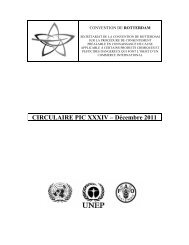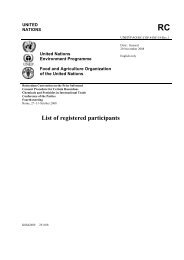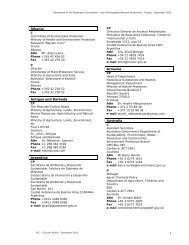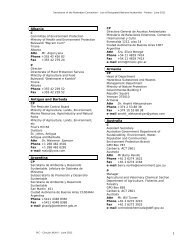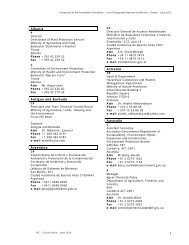RC - What is RC? - Rotterdam Convention
RC - What is RC? - Rotterdam Convention
RC - What is RC? - Rotterdam Convention
You also want an ePaper? Increase the reach of your titles
YUMPU automatically turns print PDFs into web optimized ePapers that Google loves.
precolumn from which the compounds are directly injected into the<br />
analytical column by rapid heating of the precolumn. The method was<br />
reported to be suitable for the analys<strong>is</strong> of aqueous samples by<br />
purging the precolumn following injection of the sample<br />
(0.01-0.2 cm 3 ). The analytical method developed for volatile<br />
halogenated compounds by Krost et al. (1982) was applied by<br />
Pellizari (1982) and Barkley et al. (1980). Barkley et al.<br />
(1980) also described the analys<strong>is</strong> of volatile halogenated<br />
compounds<br />
in water, blood and urine using a modification of th<strong>is</strong> method: the<br />
substances are recovered from water by heating and from biological<br />
matrices by heating and purging and are subsequently trapped on a<br />
Tenax column.<br />
A spectrophotometric method for the determination of<br />
hexachlorobutadiene in blood and urine has been reported. The<br />
method<br />
involves extraction by heptane and determination by either UV<br />
spectroscopy or colorimetry after derivatization with pyridine.<br />
Reported detection limits were 0.05 mg/litre for the UV method and<br />
5 mg/litre for the colorimetric method (Gauntley et al., 1975).<br />
Interference by other chlorinated hydrocarbons can be expected.<br />
3. SOU<strong>RC</strong>ES OF HUMAN AND ENVIRONMENTAL EXPOSURE<br />
3.1 Natural occurrence<br />
Hexachlorobutadiene has not been reported to occur as a<br />
natural<br />
product.<br />
&<br />
and<br />
3.2 Anthropogenic sources<br />
3.2.1 Production levels and processes<br />
The available data are in general of poor quality and not<br />
up-to-date. Commercial production of hexachlorobutadiene was<br />
reported to occur in Germany and Austria (SRI, 1984). In the USA,<br />
commercial production was apparently terminated around 1970 (Mumma<br />
Lawless, 1975). The compound was and <strong>is</strong> chiefly produced as<br />
by-product of the manufacture of chlorinated hydrocarbons, often in<br />
association with hexachlorobenzene. In the USA, the manufacture of<br />
tetrachloroethene, trichloroethene and carbon tetrachloride<br />
accounted in 1972 for over 99% of th<strong>is</strong> production of<br />
hexachlorobutadiene in heavy fractions, the so-called Hex-waste,<br />
amounted to 3310-6580 tonnes (Brown et al., 1975; Mumma & Lawless,<br />
1975; Yurawecz et al., 1976; see also section 3.2.3). It was also<br />
reported to be a by-product of the manufacture of vinyl chloride,<br />
allyl chloride and epichlorohydrin by chlorinolys<strong>is</strong> processes (Kusz<br />
et al., 1984). Hexachlorobutadiene has been identified in the<br />
effluents of sewage treatment plants (section 5.2) and as a<br />
by-product of the pyrolys<strong>is</strong> of trichloro-ethene (Yasuhara & Morita,<br />
1990) and plastics (Singh et al., 1982). The annual world<br />
production of hexachlorobutadiene in heavy fractions was estimated<br />
in 1982 to be 10 000 tonnes (Hutzinger, 1982). No data have been



